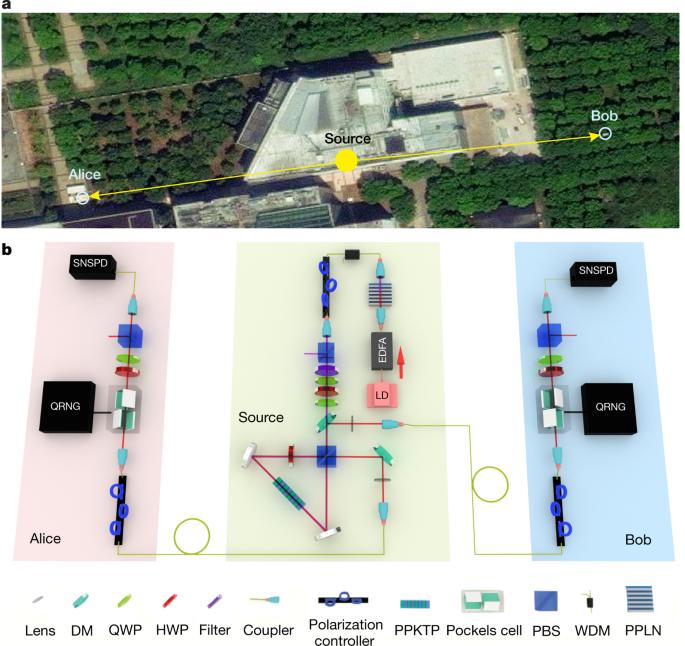Device-independent quantum random-number generation
IF 48.5
1区 综合性期刊
Q1 MULTIDISCIPLINARY SCIENCES
引用次数: 159
Abstract
Randomness is important for many information processing applications, including numerical modelling and cryptography1,2. Device-independent quantum random-number generation (DIQRNG)3,4 based on the loophole-free violation of a Bell inequality produces genuine, unpredictable randomness without requiring any assumptions about the inner workings of the devices, and is therefore an ultimate goal in the field of quantum information science5–7. Previously reported experimental demonstrations of DIQRNG8,9 were not provably secure against the most general adversaries or did not close the ‘locality’ loophole of the Bell test. Here we present DIQRNG that is secure against quantum and classical adversaries10–12. We use state-of-the-art quantum optical technology to create, modulate and detect entangled photon pairs, achieving an efficiency of more than 78 per cent from creation to detection at a distance of about 200 metres that greatly exceeds the threshold for closing the ‘detection’ loophole of the Bell test. By independently and randomly choosing the base settings for measuring the entangled photon pairs and by ensuring space-like separation between the measurement events, we also satisfy the no-signalling condition and close the ‘locality’ loophole of the Bell test, thus enabling the realization of the loophole-free violation of a Bell inequality. This, along with a high-voltage, high-repetition-rate Pockels cell modulation set-up, allows us to accumulate sufficient data in the experimental time to extract genuine quantum randomness that is secure against the most general adversaries. By applying a large (137.90 gigabits × 62.469 megabits) Toeplitz-matrix hashing technique, we obtain 6.2469 × 107 quantum-certified random bits in 96 hours with a total failure probability (of producing a random number that is not guaranteed to be perfectly secure) of less than 10−5. Our demonstration is a crucial step towards transforming DIQRNG from a concept to a key aspect of practical applications that require high levels of security and thus genuine randomness7. Our work may also help to improve our understanding of the origin of randomness from a fundamental perspective. Genuine, unpredictable quantum random-number generation that is provably secure against quantum and classical adversaries is demonstrated, certified by the loophole-free violation of a Bell inequality.

独立于设备的量子随机数生成
随机性对许多信息处理应用都很重要,包括数值建模和密码学1,2。基于无漏洞违反贝尔不等式的独立于设备的量子随机数生成(DIQRNG)3,4 能产生真正的、不可预测的随机性,而无需对设备的内部工作原理做出任何假设,因此是量子信息科学领域的终极目标5-7。之前报道的 DIQRNG8,9 实验演示无法证明其在对抗最一般对手时的安全性,也没有堵住贝尔检验的 "局部性 "漏洞。在这里,我们提出了能安全对抗量子和经典对手的 DIQRNG10-12。我们使用最先进的量子光学技术来创建、调制和检测纠缠光子对,在约 200 米的距离内,从创建到检测的效率超过 78%,大大超过了贝尔测试中关闭 "检测 "漏洞的阈值。通过独立、随机地选择测量纠缠光子对的基准设置,并确保测量事件之间的类空间隔离,我们还满足了无信号条件,堵住了贝尔检验的 "局域性 "漏洞,从而实现了无漏洞地违反贝尔不等式。这样,再加上高电压、高重复率的波克尔斯单元调制装置,我们就能在实验时间内积累足够的数据,从而提取出真正的量子随机性,并能安全地对抗最一般的对手。通过应用大型(137.90 千兆比特 × 62.469 兆比特)托普利兹矩阵哈希技术,我们在 96 小时内获得了 6.2469 × 107 个量子认证随机比特,总失败概率(产生不保证完全安全的随机数)小于 10-5。我们的演示是将 DIQRNG 从一个概念转化为实际应用的一个关键方面的关键一步,而实际应用需要高水平的安全性,因此也需要真正的随机性7。我们的工作还有助于从根本上提高我们对随机性起源的理解。我们证明了真正的、不可预测的量子随机数生成,它可以安全地对抗量子和经典对手,并通过无漏洞地违反贝尔不等式得到验证。
本文章由计算机程序翻译,如有差异,请以英文原文为准。
求助全文
约1分钟内获得全文
求助全文
来源期刊

Nature
综合性期刊-综合性期刊
CiteScore
90.00
自引率
1.20%
发文量
3652
审稿时长
3 months
期刊介绍:
Nature is a prestigious international journal that publishes peer-reviewed research in various scientific and technological fields. The selection of articles is based on criteria such as originality, importance, interdisciplinary relevance, timeliness, accessibility, elegance, and surprising conclusions. In addition to showcasing significant scientific advances, Nature delivers rapid, authoritative, insightful news, and interpretation of current and upcoming trends impacting science, scientists, and the broader public. The journal serves a dual purpose: firstly, to promptly share noteworthy scientific advances and foster discussions among scientists, and secondly, to ensure the swift dissemination of scientific results globally, emphasizing their significance for knowledge, culture, and daily life.
 求助内容:
求助内容: 应助结果提醒方式:
应助结果提醒方式:


